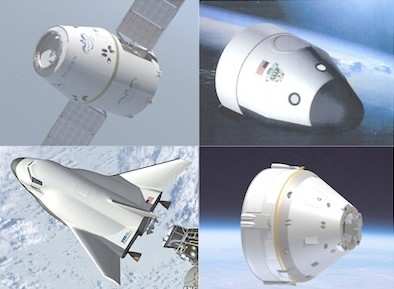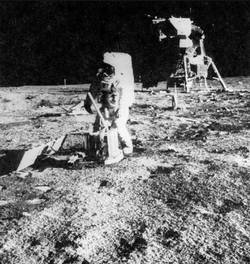The Answer Is A Qualified 'Yes'
Aero-Commentary by Wes Oleszewski
Over the long July holiday weekend I took the time to simply sit and chat with friends and neighbors and enjoy the fine summer weather. For some reason whenever I’m in a group such as that, someone, other than myself, brings up the subject of spaceflight. Such was the case on more than one occasion over the weekend- perhaps because I was wearing a Space Shuttle T-shirt. While talking about the potential for star-gazing in the impending clear night, one of my neighbors raised a half-serious, half-cynical question; “Do we even have a space program anymore?”

At first I wanted to reply with an equally cynical answer- as is my cynical nature. Instead, I glanced around and saw a few of the people seated nearby with looks of concern on their faces. So I gave them a straight answer. My reply was ... sure we still have a space program. I called attention to the rovers on Mars, New Horizons passing by Pluto next summer and astronauts on the ISS.
“Wait a second,” the neighbor continued in cynicism, “we don’t even launch those astronauts. We have to hire the Russians to fly them to the space station. What’s up with that?”
It took a few minutes for me to explain the current “gap” in US manned spaceflight capability. Then I went on to outline how NASA had a Commercial Crew program and that companies such as Boeing, Sierra Nevada and SpaceX were competing to take over that job of taxi services to the ISS.
“SpaceX,” the cynic scoffed, “every time I see something about them on the Internet they’ve scrubbed.”
Trying not to get too deeply into the debate of whether or not the concept of commercial crew was working out as advertized, I simply explained that the task that these companies have taken on is not easy. These companies are developing totally new hardware to do the job. Scrubs and delays are a part of the process. Plus, a scrub is better than a major failure.
“Well, didn’t Apollo do the same thing?” my friend replied, “They started out and had to develop all new equipment and within about 10 years we were driving on the Moon.”
I countered with the fact that commercial crew has a very tight budget to work with, but Apollo in the early 1960s practically had a blank check to get us to the Moon.

“What about the Moon?” he asked, “How come some other country hasn’t gone there already? I mean, it’s so easy.”
This was an easy misconception to swat out of the ballpark. Going to the moon was NEVER easy. The problem is that NASA made it look easy and the news media of the day sold it as being close to routine. Any nation, China, Russia, or even us in the United States, that tries to again send humans to the Moon is going to discover in a big way just how hard it really is. Astronauts on the lunar surface is simply the tip of the iceberg. Behind every one of those missions were as many as 350,000 people who in one way or another had a hand in making it happen. From the guy with shovel and red clay on his work boots who worked on the construction of the foundations of the engine test stands, to the software wizards at MIT who wrote the programs for the CSM and LEM computers, a vast array of unseen Americans were employed in Apollo. It took an industrial trades base of people and an army of persons trained in scientific concentrations to make it all happen. In the United States, we have taken that capability and
simply laid it off. In other nations they have yet to fully develop it.
“Then why don’t we just go back to the Moon?” the cynic asked, “I thought we were gonna do that. What happened there?”
Now my own cynical ability simply kicked in and I answered his question with a question,
“Who’d you vote for in 2008?”
“Obama,” he replied with a slight sneer.
“There’s your answer,” I replied.

The fact is that we Americans do indeed still have a “space program.” The problem resides in two presidential administrations who were disingenuous about their support for the manned portion of our program. The Congress has broadly supported NASA’s human spaceflight program for more than the past decade, although they are currently not sold on the commercial crew concept. Meanwhile, the public perception is that we have nothing when it comes to spaceflight. Although NASA is making an effort to show what may come to pass in the future, they are stuck with little more than computer animation and fancy Powerpoint slides while the launch pads at KSC remain mute.
The roar of rockets speaks much louder to the public than the glitz of computer animation.
Hopefully that will all begin to change in December of 2014. The Orion is the first new manned spacecraft for NASA in more than 30 years and its first unmanned test flight will be launched into space atop a Delta IV Heavy launch vehicle from Cape Canaveral’s LC37 sometime in December. Maybe then, even cynics will have to take notice.
 ANN's Daily Aero-Term (04.24.24): Runway Lead-in Light System
ANN's Daily Aero-Term (04.24.24): Runway Lead-in Light System ANN's Daily Aero-Linx (04.24.24)
ANN's Daily Aero-Linx (04.24.24) Aero-FAQ: Dave Juwel's Aviation Marketing Stories -- ITBOA BNITBOB
Aero-FAQ: Dave Juwel's Aviation Marketing Stories -- ITBOA BNITBOB Classic Aero-TV: Best Seat in The House -- 'Inside' The AeroShell Aerobatic Team
Classic Aero-TV: Best Seat in The House -- 'Inside' The AeroShell Aerobatic Team Airborne Affordable Flyers 04.18.24: CarbonCub UL, Fisher, Affordable Flyer Expo
Airborne Affordable Flyers 04.18.24: CarbonCub UL, Fisher, Affordable Flyer Expo





